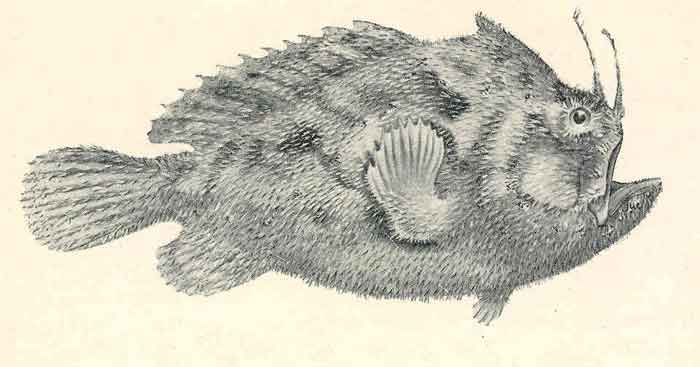Superregnum: Eukaryota
Cladus: Unikonta
Cladus: Opisthokonta
Cladus: Holozoa
Regnum: Animalia
Subregnum: Eumetazoa
Cladus: Bilateria
Cladus: Nephrozoa
Superphylum: Deuterostomia
Phylum: Chordata
Subphylum: Vertebrata
Infraphylum: Gnathostomata
Megaclassis: Osteichthyes
Superclassis/Classis: Actinopterygii
Classis/Subclassis: Actinopteri
Subclassis/Infraclassis: Neopterygii
Infraclassis: Teleostei
Megacohors: Osteoglossocephalai
Supercohors: Clupeocephala
Cohors: Euteleosteomorpha
Subcohors: Neoteleostei
Infracohors: Eurypterygia
Sectio: Ctenosquamata
Subsectio: Acanthomorphata
Divisio/Superordo: Acanthopterygii
Subdivisio: Percomorphaceae
Series: Eupercaria
Ordo: Lophiiformes
Subordo: Antennarioidei
Familia: Antennariidae
Genus: Echinophryne
Species: E. crassispina – E. mitchellii – E. reynoldsi
Name
Echinophryne McCulloch & Waite, 1918
Gender: feminine
Type species: Echinophryne crassispina McCulloch & Waite, 1918, by original designation and monotypy.
References
McCulloch, A. R. & E. R. Waite (1918) Some new and little-known fishes from South Australia. Records of the South Australian Museum (Adelaide) v. 1 (no. 1): 39–78, Pls. 2-7.
Links
Echinophryne – Taxon details on Integrated Taxonomic Information System (ITIS).

Echinophryne mitchellii
Echinophryne is a genus of marine ray-finned fishes belonging to the subfamily Histiophryninae in the family Antennariidae, the frogfishes. The fishes in this genus are endemic to the waters off Australia.
Taxonomy
Echinophryne was first proposed as a genus in 1918 by the Australian ichthyologists Allan Riverstone McCulloch and Edgar Ravenswood Waite with Echinophryne crassispina, a species being newly described by McCulloch and Waite, being designated as the type species as well as being its only species.[1] Some authorities classify this genus in the subfamily Histiophryninae within the family Antennariidae.,[2] while others recognise it as the family Histiophrynidae.[3] However, the 5th edition of Fishes of the World does not recognise subfamilies within the Antennariidae, classifying the family within the suborder Antennarioidei within the order Lophiiformes, the anglerfishes.[4]
Etymology
Echinophryne combines echinos, meaning "spiny", a reference to the skin of the type species which was described as “thickly beset with large, upstanding, bifurcate spinules”, with phryne, meaning "toad", a common used suffix for anglerfish genera, it may date as far back as Aristotle and Cicero, who referred to anglerfishes as “fishing-frogs” and “sea-frogs,” respectively, this is assumed to be an allusion to the frog- or toad-like appearance of these fishes.[5]
Species
Echinophryne has three recognised species classified within it:[6]
Echinophryne crassispina McCulloch & Waite, 1918 (Prickly anglerfish)
Echinophryne mitchellii (Morton, 1897) (Long-spined anglerfish)
Echinophryne reynoldsi Pietsch & Kuiter, 1984 (Sponge anglerfish)
Characteristics
Echinophryne anglerfishes have the second and third dorsal spines free of the skin and not hidden underneath it. The rough skin is densely covered in denticles. there is a caudal peduncle and the rearmost margins of the dorsal and anal fins are attached to the caudal peduncle in front of the base of the caudal fin. The illicium is covered by closely set denticles and lacks a bulbous lure, or esca.[2] These are relatively small fishes with the largest species being the long-spined anglerfish (E. mitchelli) which has a maximum published standard length of 11.1 cm (4.4 in).[6]
Distribution and habitat
Echinophryne anglerfishes are endemic to Australia, they are found along the southern coasts of Australia from King George Sound (Western Australia) in Western Australia[7] to Jervis Bay in New South Wales, including Tasmania.[8] One species, the prickly anglerfish, is found in rocky reefs, frequently under rocks, ledges and around jetties[8] while the sponge anglerfish inhabits rocky reefs where it associates with sponges.[7] They are found as deep as 70 m (230 ft).[9]
References
Eschmeyer, William N.; Fricke, Ron & van der Laan, Richard (eds.). "Genera in the family Histiophrynidae". Catalog of Fishes. California Academy of Sciences. Retrieved 9 April 2024.
Arnold, R. J.; R. G. Harcourt; and T. W. Pietsch (2014). "A new genus and species of the frogfish family Antennariidae (Teleostei: Lophiiformes: Antennarioidei) from New South Wales, Australia, with a diagnosis and key to the genera of the Histiophryninae". Copeia. 2014 (3): 534–539. doi:10.1643/CI-13-155.
Froese, Rainer; Pauly, Daniel (eds.). "Family Histiophrynidae". FishBase. February 2024 version.
Nelson, J.S.; Grande, T.C.; Wilson, M.V.H. (2016). Fishes of the World (5th ed.). Hoboken, NJ: John Wiley & Sons. pp. 508–518. doi:10.1002/9781119174844. ISBN 978-1-118-34233-6. LCCN 2015037522. OCLC 951899884. OL 25909650M.
Christopher Scharpf (14 November 2022). "Order LOPHIIFORMES (part 1): Families LOPHIIDAE, ANTENNARIIDAE, TETRABRACHIIDAE, LOPHICHTHYIDAE, BRACHIONICHTHYIDAE, CHAUNACIDAE and OGCOCEPHALIDAE". The ETYFish Project Fish Name Etymology Database. Christopher Scharpf. Retrieved 9 April 2024.
Froese, Rainer; Pauly, Daniel (eds.). "Species in genus Echinophryne". FishBase. February 2024 version.
Dianne J. Bray & Vanessa J. Thompson. "Echinophryne reynoldsi". Fishes of Australia. Museums Victoria. Retrieved 9 April 2024.
Dianne J. Bray & Vanessa J. Thompson (2020). "Echinophryne crassispina". Fishes of Australia. Museums Victoria. Retrieved 9 April 2024.
Bray, D.J. (2018). "Echinophryne mitchellii". Fishes of Australia. Museums Victoria. Retrieved 9 April 2024.
Retrieved from "http://en.wikipedia.org/"
All text is available under the terms of the GNU Free Documentation License

